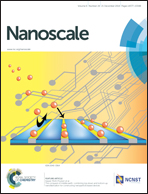Amphiphilic copolymer coated upconversion nanoparticles for near-infrared light-triggered dual anticancer treatment†
Abstract
The light-triggered controlled release of anticancer drugs accompanied with NIR-responsive photodynamic therapy was prepared via a self-assembly process. Firstly, Mn2+-doped upconversion nanoparticles (UCNPs) were coated with a mesoporous silica shell and modified with photosensitizer (Chlorin e6) and long alkyl chains. And then the NIR light-responsive amphiphilic copolymer containing 9,10-dialkoxyanthracene groups was synthesized and then coated as the outermost layer. Upon irradiation with a 980 nm laser, the CCUCNPs@PM would absorb and then convert the NIR light to higher-energy visible red light (660 nm) via the UCNPs-based core, which could excite Chlorin e6 (Ce-6) to produce singlet oxygen (1O2). Then the 1O2-sensitive dialkoxyanthracene group in the amphiphilic copolymer would be degraded and detach from the surface of the CCUCNPs@PM, followed by the controlled release of the pre-loaded drugs and the photodynamic therapy for cancer cells caused by the excess 1O2. In vitro and in vivo experiments also demonstrated that the drug-loaded CCUCNPs@PM possessed better therapeutic efficacy compared with vacant ones. Therefore, the NIR light-controlled chemotherapy and photodynamic therapy could be realized simultaneously by CCUCNPs@PM.


 Please wait while we load your content...
Please wait while we load your content...